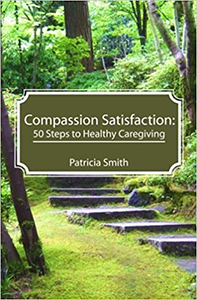Compassion Fatigue: Repetitive Stress of the Heart
Patricia Smith, author
When caregivers focus on others without practicing authentic self-care, destructive behaviors can surface such as:
- Apathy
- Isolation
- Bottled-up emotions
- Substance abuse
- Lack of personal hygiene practices
- Emotional outbursts
These symptoms head a long list of symptoms associated with the secondary traumatic stress disorder now labeled: Compassion Fatigue.
Studies confirm that animal caregivers play host to a high level of compassion fatigue. Day in and day out, animal welfare workers struggle to function in an industry where euthanizing what they love most is the norm. Effecting positive change in this arena is perceived as elusive, if not impossible. This painful reality, coupled with first-hand knowledge of the flagrant disregard for the safety and well-being of animals, takes its toll on everyone from full-time euthanasia technicians to part-time volunteers. And eventually, negative attitudes prevail.
When compassion fatigue hits critical mass in the workplace, the organization suffers. Chronic absenteeism, rising workers’ compensation insurance costs, high turnover rates, friction among employees, and friction between staff and management all surface, creating additional stress on workers.
While the effects of compassion fatigue are dismal, chances for recovery are not. Compassion fatigue is a term, not a disease. The associated symptoms are normal displays of chronic stress resulting from the caregiving work we choose to do.
Leading traumatologists Eric Gentry suggests that people who are attracted to animal care often enter the field already compassion fatigued. A strong identification with the helpless, victimized animal is often the motivator. It is common for such people to hail from a tradition which is recognized as “other-directed.” Simply put, these people were taught at an early age to care for the needs of others before caring for their own needs.
If you sense that you are suffering from compassion fatigue, chances are excellent that you are. Your path to wellness begins with awareness. A heightened awareness can lead to insights regarding past traumas that are still affecting your life and choices. With the appropriate information and support, you can embark on a journey of discovery that can heal the past that currently serves as an obstacle to your successful self care.
Healing begins by employing such simple practices as:
- Regular exercise
- Healthy eating habits
- Enjoyable social activities
- Journaling
- Restful sleep
Accepting the presence of compassion fatigue in your life only serves to validate the fact that you are a deeply caring individual. Somewhere along your healing path, the truth will present itself. You’ll learn that you don’t have to make a choice. It is possible to practice healthy self-care while continuing to care for others.
This article was first presented at the American Humane Conference 2003
The CFAP Newsroom features articles and interviews written by Founder Patricia Smith or reference CFAP's ongoing mission to raise awareness and promote authentic, sustainable self care...
Read all about it here!
Help us create another exciting venue for raising compassion fatigue awareness! We'll post new information on a regular basis. Become a fan!
With more than 20 years of training experience, CFAP Founder Patricia Smith writes, speaks and facilitates workshops in service of those who care for others.
If you're interested in having Patricia address your organization or group, click here!
For every $1,000 we receive in donations, we are donating 50 sets of Patricia Smith's books to organizations across the nation that are in need of this vital first step toward authentic, sustainable self-care.
Join the Challenge here!

CFAP Founder Patricia Smith's newest book guides readers through 50 steps to Compassion Satisfaction.
Pick up a copy here!

